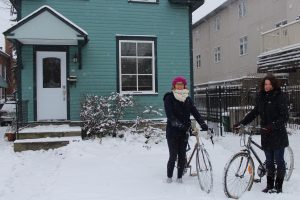
Emma Cousins rented a 100-year-old home in August, and admits to being curious about the memories her Centretown residence holds.
“I love living in an older home,” she said. “It’s like buying a used book. It has more memories in it. You think about who lived here, who built the house, what did it look like before it was renovated.”

Cousins’ house is a solid brick, three-bedroom duplex standing on 273 Bronson Ave near the city’s downtown core. The interior has a narrow stairway that leads to a living room with a dangling chandelier, a ceiling with faint renovation marks and an old-school fan.
Another stairway that Cousins described as having a “little turn at the bottom like an elbow,” leads to the attic where there are two rooms. The vent covers have intricate designs that are not common in more modern houses. These features remind Cousins that her house is old.

“Older homes tend to take more care on how little details look to make it more aesthetically appealing,” she said.
According to an analysis of Statistics Canada data from the 2011 National Household Survey, Cousins’s home is one of more than 2,000 residences scattered among the neighbourhoods in the Somerset ward that were built before 1960. The ward has the highest number of these old houses in Ottawa.
Number of pre-1960 residential houses in Ottawa by ward (click on the panel in the map to see the map’s legend)
Source: Statistics Canada, 2011 National Household Survey
“The city grew from inside out,” Robert Smythe, an urban historian said about the reason most of Ottawa’s oldest houses are in this part of the city.
He added that the downtown area was first to be partitioned into small building lots which were built upon by developers and contractors between the 1870s and 1900s.
In the northern half of the city, most of the old buildings were demolished to create space for office buildings and parking lots, Smythe said. Even those buildings that survived have in some cases been transformed from single family dwellings to apartments.
But those that remain still hold a great appeal to people like Cousins.
“Today there is a premium on heritage, primarily because of their special character and central location,” Smythe said.
That special character inspired Jordan Sanders, an occupational psychologist from Vancouver, to buy a 68-year-old home in the Kitchissippi, the ward with almost 2,000 of these houses, the second highest in Ottawa.

“When you walk into some of the rooms, it has really clear archways,” Sanders said about his home. “It has a rustic sort of style to it that I appreciate.”
Sander’s house, a 2,800 square feet property, was built by two brothers who owned a construction business. The brothers built the house in 1948 after deciding they wanted to live together. However, it has seen a drastic facelift since it was built.
Despite their appeal, some of these houses are not without problems.
“Older homes are harder to heat if it wasn’t insulated properly,” Cousins said. “Our bedrooms are upstairs in the attic so it gets really hot in the summer and really cold in the winter. There’s a heater up there. I have to keep the heat on constantly to keep it at a decent temperature.”

“The floor slants down, it curves down in the middle so if you spill water it all runs into one spot and that’s such an older home thing,” she added.
The city encourages proper maintenance of these old houses, said local historian Smythe.
“Changes to houses in heritage districts are now regulated by the city’s heritage zoning and designation,” he said. “There are minor grants available to heritage properties, but their retention is largely dependent upon the dedication of their owners.”
(Click on the annotation to see the City of Ottawa article about how to identify and protect heritage properties)

































